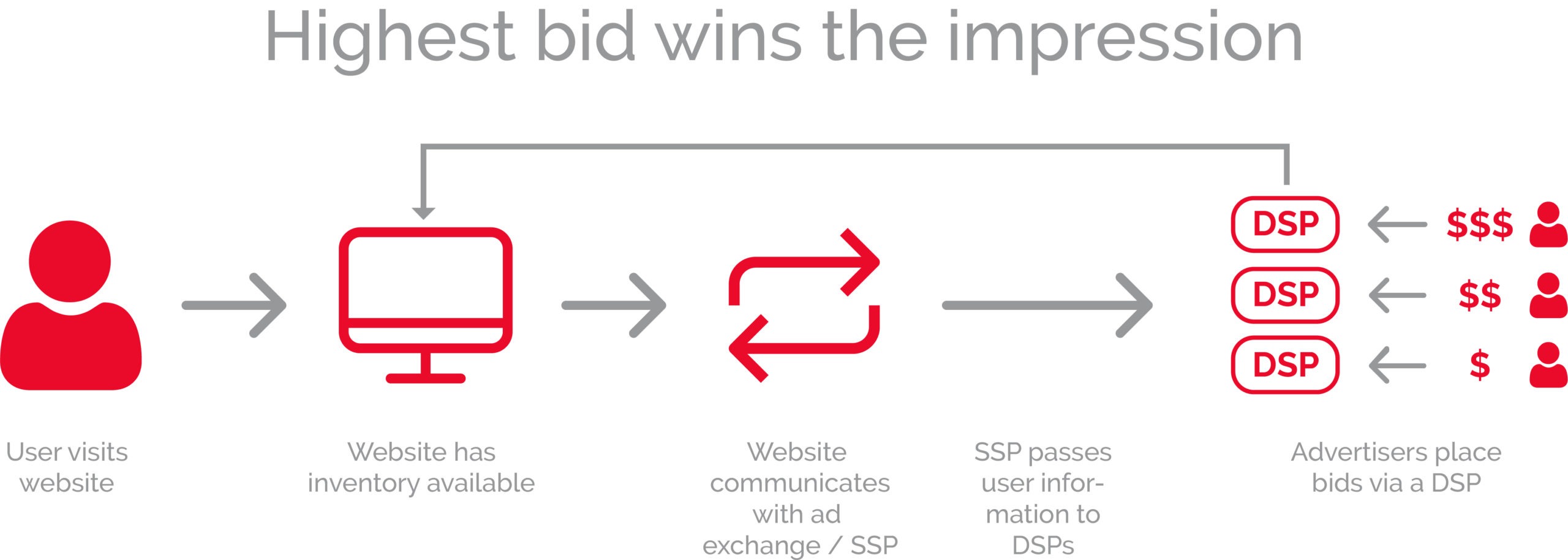Guide to Programmatic Advertising and What It’s All About
When it comes to digital advertising, programmatic advertising is quickly becoming the new standard. In less than a year, programmatic advertising has grown from a niche segment to the primary form of digital advertising.
With advertisers clamouring for more cost-effective ways to reach target audiences, programmatic advertising has become ideal for reaching those consumers with just the right message at just the right time.
In this article, we’ll discuss what programmatic advertising is and how it works as well as outline some of the key benefits and risks involved in using it. If you’re already sold on investing in programmatic ad campaigns or you simply need to know more before making that decision then read on!
What is Programmatic Advertising?
Programmatic advertising is similar to other forms of digital advertising in that it uses computer algorithms to target users with the right message at just the right time.
The difference between programmatic and traditional advertising is how they use data to reach consumers. Traditional marketing uses people, whereas programmatic marketing uses data to reach people.
So what are the benefits of programmatic advertising?
Programmatic ads are able to run across multiple websites and channels—targeting their audience’s specific needs for a fraction of the cost you would normally spend on traditional methods.
Additionally, these campaigns are able to utilise data-driven insights into your ideal customer’s day-to-day habits so your ad will have a better chance of being seen by them at just the right time.
Another benefit of using programmatic ads is that they can be used as a way to drive traffic back to your website or blog. For example, if an ad campaign was set up for a travel website, those clicks could be turned into revenue through direct sales on your website or blog store.
What is a programmatic ad network?
A programmatic ad network is an advertising platform that uses automation and real-time bidding to enhance revenue. Programmatic technology and bots (automated programs) are able to collect, analyse, and sell data about consumers in order to deliver personalised experiences across multiple platforms.
Programmatic advertising is a non-traditional form of advertising that allows for precise targeting of audiences through information the quality of which can be matched by search engine optimization (SEO).
The ability for advertisers to target specific users based on their demographics, location, interests, social media following, or other variables makes this type of marketing an effective way to reach customers with the most appropriate offers at the optimal time.
In addition to being able to target specific demographic groups more effectively, programmatic advertising also has another advantage. It can collect data in real time and make changes based on what it learns about consumers’ preferences—meaning marketers have more control over who sees their advertisements.
This gives advertisers a better chance of reaching the right customers with their ads and increasing sales as a result.

Why use programmatic ads?
One of the benefits of using programmatic ads is that they are more affordable than other types of advertising. They also work better because they are targeted to the right people.
Because programmatic ads can be delivered to the right people, you have a better chance at getting your ad seen by the right person and making an impression. With them, you can optimise your campaign so that it is cost-effective and still reaches people who want what you have to sell.
Another reason why you should use programmatic ads is because they are measurable. You can track which ad generated a sale or how many clicks you received on your offer page. This allows you to analyse your marketing campaigns and make adjustments accordingly.
You’ll know exactly where to put your focus for the next campaign.
Furthermore, using programmatic ads helps increase customer loyalty because customers feel like they are receiving special treatment when they see those flashy offers pop up on their screens without having to click through from a website or app.
It also increases brand awareness because customers will recognise those flashy offers as being affiliated with a company or product that they’re familiar with and trust
A programmatic ad network allows publishers and advertisers to place ads on a website without the need for them to be manually added by a human. This can save a lot of time for both the publisher and the advertiser, as well as reduce costs.
Programmatic ads are similar to other types of ads, however are more relevant to the content of the website through the use of programmatic bidding. This allows advertisers to target the right audience, regardless of where they are on the site.
It’s also important to note that with ad networks, publishers have the opportunity to earn revenue on every ad they generate. This can be done through a pay-per-click or pay-per-impression model.
How to use programmatic advertising effectively
In order to use programmatic advertising effectively, you should understand what it takes to run a successful campaign in the digital ad space. There are four crucial steps in every programmatic campaign: targeting, bidding, optimization and measurement.
Targeting refers to finding the right audience for your advertisement. This starts with understanding who your target is and how best to reach them. Next, you must decide on the channels through which your ads will be distributed.
Once you’ve found the correct audience and distribution channels, you can decide on what types of ads will work best for them and when they’re most likely to see them. This all leads up to bidding where you specify how much money you want your campaign to cost per click (CPC) or per impression (CPM).

Advantages of using programmatic advertising
Programmatic advertising is the fastest growing type of digital advertising and offers a range of benefits.
With programmatic advertising, you can easily target your audience with ad campaigns that automatically reach the people most likely to be interested in your product or service.
It’s also one of the most cost-effective ways to advertise online, with prices often being 20 times less than other forms of digital advertising.
Additionally, programmatic ads can reach consumers even if they are not actively seeking information about your product or service. This means you don’t have to worry about spending money on ads that aren’t going to get seen by their intended audiences. Your ad may be spreading virally without you even knowing it!
And lastly, programmatic advertising offers the ability to send personalised promotions at just the right time via push notifications or email.
For example, if your company is trying to get people excited for a new product release, you can build an automated campaign that sends out push notifications when a specific date has been reached so that people are constantly reminded about this major event and inclined to purchase what is being advertised.
Disadvantages of using programmatic advertising
Programmatic advertising is a powerful tool, however it also has downsides. The biggest disadvantage of using programmatic advertising is its unpredictability.
Unlike other types of advertising such as search engine optimization (SEO), where you can be sure that your ads will appear on the first page of searches for your target keyword, you’re not always certain about how your ads will perform with programmatic advertising.
This is especially true if you rely on an ad network or advertiser to select which audience sees your ad. Your campaign could be shown to the wrong audience or it could be shown in the wrong place altogether.
Another disadvantage of using programmatic advertising is that it limits your ability to personalise campaigns based on individual consumer behaviour. Programmatic ads are automatically served and cannot be customised by the person viewing them, so you won’t get a chance to show different messages to different people.
In the digital advertising world, there is always a risk of fraud and ad-buying scams. These risks are especially high in programmatic advertising as ad campaigns are being carried out through automated algorithms, which means that the human factor is removed from the equation.
Automated systems for marketing purposes can introduce unintended bias and conflicts of interest into the process.
Additionally, programmatic advertising does not provide any opportunities for brand transparency or consumer choice; two things that advertisers need to be able to communicate with their audience.
This lack of transparency could lead to consumers feeling misled or disenfranchised by ads that they see on social media feeds or on websites.
Conclusion
With the increased use of programmatic advertising, companies are able to spend less money on ads in exchange for more visibility and higher click through rates.
While programmatic advertising is becoming more and more popular, it can also be a risky decision for a business. To ensure your brand is successful with programmatic advertising, follow these simple steps to ensure success.
Programmatic advertising can be a risk, however it’s a risk that can be mitigated. Start by following these steps to ensure your brand is successful with programmatic advertising.






